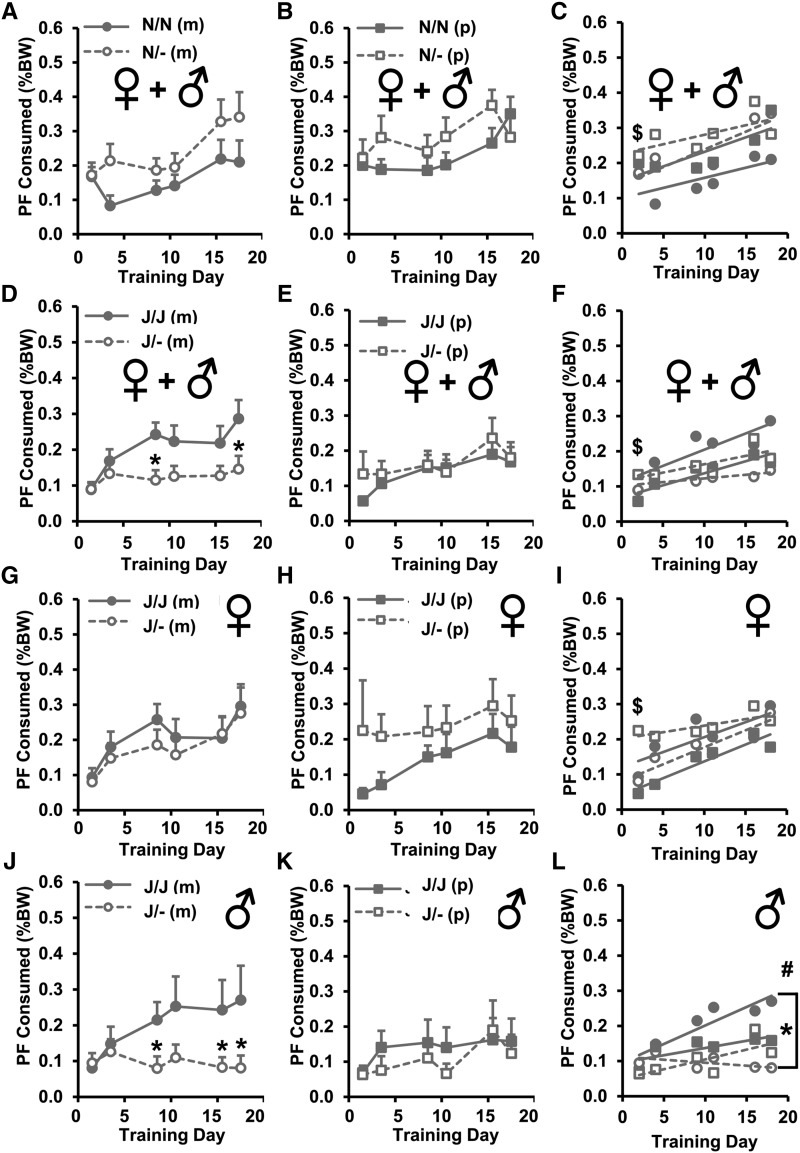Figure 5.
Effect of Parent-of-Origin (PO) and Sex on PF consumption in Cyfip1N/- and Cyfip1J/- mice. (A,B): For the Cyfip1,2N/N background, there was an effect of Genotype [F(1,464) = 12.3; P = 0.0005], PO [F(1,464) = 9.0; P = 0.003], Sex [F(1,464) = 39.4; P = 8.0 × 10−10], and Day [F(1,464) = 20.8, P = 6.5 × 10−6]. Cyfip1N/- mice consumed more PF than Cyfip1N/N mice on Day (D)4 [A: t(29) = 2.1; *P = 0.046]. Females consumed more PF than males (not shown). (C): No differences were observed among the groups in the slopes of escalation in PF consumption [F(3,16) = 0.7 P = 0.56]; however, paternally-deleted Cyfip1N/- mice (open squares) showed a greater y-intercept than either of the Cyfip1N/N wild-type groups ($: both p’s < 0.02), indicating a greater overall consumption. Furthermore, Cyfip1N/N mice derived from paternal deletion showed a greater y-intercept than Cyfip1N/N mice derived from maternal deletion (P = 0.046). (D,E): For the Cyfip1,2J/J background, there was an effect of Genotype [F(1,600) = 5.2; P = 0.02], Sex [F(1,600) = 14.1; P = 0.0002], Day [F(5,600) = 4.4; P = 0.0006], a Genotype x Sex interaction [F(1,600) = 10.8; P = 0.001], and a Genotype x PO interaction [F(1,600) = 9.3; P = 0.002] that reflected less PF consumption in maternally deleted Cyfip1J/- (m) mice [D: t(59) = 2.9, 2.2; *P = 0.005, 0.03 vs. their Cyfip1J/J counterparts on Day (D)9 and D18, respectively] but no genotypic differences between paternally deleted Cyfip1J/- (p) mice vs. their Cyfip1 J/J (p) counterparts (E). (F): Both maternal and paternal wild-type Cyfip1J/J groups showed significant slope in escalation of intake [Cyfip1J/J (m): F(1,184) = 10.9; P = 0.001; Cyfip1 J/J (p): F(1,142) = 8.4; P = 0.005; closed symbols]. In contrast, neither mutant Cyfip1J/- group showed a significant slope from zero (both ps > 0.15; open symbols). Moreover, paternally deleted Cyfip1J/- (p) mice (open squares) had a greater y-intercept than all three other groups ($ all p’s < 0.0004). (G-I): To understand the source of the above interactions, we next separated PO effects of Cyfip1J/- by Sex. (G-H): In females, there was an effect of Day [F(5,288) = 3.6; P = 0.004] and a Genotype x PO interaction [F(1,288) = 7.1; P = 0.008]. (I): Both Cyfip1J/J wild-type female groups showed a significant slope in escalation (I; both ps < 0.02 vs. zero) as well as maternally-deleted Cyfip1J/- (m) females (P = 0.002 vs. zero). Paternally deleted Cyfip1J/- (p) mice did not show a significant non-zero slope (P = 0.5) but showed the greatest y-intercept compared to all three groups ($P < 0.0002), indicating an initially higher, stable PF consumption across time. (J-L): For males, there was an effect of Genotype [F(1,312) = 13.6; P = 0.0003] and a trending Genotype x PO interaction [F(1,312) = 3.3; P = 0.07]. Maternally deleted Cyfip1J/- (m) males showed significantly less PF intake than their wild-type Cyfip1J/J (m) male counterparts (J: *P < 0.03, 0.04, and 0.04 vs. Cyfip1J/J on D9, D16, and D18, respectively). In contrast, there was no genotypic difference in paternally-deleted Cyfip1J/- (p) males vs. their wild-type Cyfip1J/J (p) male counterparts (panel K). For slope analysis, only the wild-type Cyfip1 J/J (m) males showed a significant slope in escalation of consumption (#P = 0.03 vs. zero) that was also significantly greater than their mutant Cyfip1J/- (m) male counterparts (*P = 0.01; L). Data are presented as mean ± SEM.

